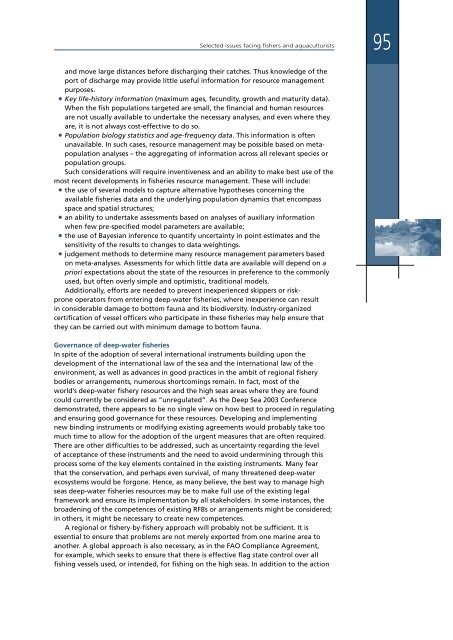State of World Fisheries and Aquaculture 2004 - Library
State of World Fisheries and Aquaculture 2004 - Library
State of World Fisheries and Aquaculture 2004 - Library
Create successful ePaper yourself
Turn your PDF publications into a flip-book with our unique Google optimized e-Paper software.
Selected issues facing fishers <strong>and</strong> aquaculturists<br />
95<br />
<strong>and</strong> move large distances before discharging their catches. Thus knowledge <strong>of</strong> the<br />
port <strong>of</strong> discharge may provide little useful information for resource management<br />
purposes.<br />
• Key life-history information (maximum ages, fecundity, growth <strong>and</strong> maturity data).<br />
When the fish populations targeted are small, the financial <strong>and</strong> human resources<br />
are not usually available to undertake the necessary analyses, <strong>and</strong> even where they<br />
are, it is not always cost-effective to do so.<br />
• Population biology statistics <strong>and</strong> age-frequency data. This information is <strong>of</strong>ten<br />
unavailable. In such cases, resource management may be possible based on metapopulation<br />
analyses – the aggregating <strong>of</strong> information across all relevant species or<br />
population groups.<br />
Such considerations will require inventiveness <strong>and</strong> an ability to make best use <strong>of</strong> the<br />
most recent developments in fisheries resource management. These will include:<br />
• the use <strong>of</strong> several models to capture alternative hypotheses concerning the<br />
available fisheries data <strong>and</strong> the underlying population dynamics that encompass<br />
space <strong>and</strong> spatial structures;<br />
• an ability to undertake assessments based on analyses <strong>of</strong> auxiliary information<br />
when few pre-specified model parameters are available;<br />
• the use <strong>of</strong> Bayesian inference to quantify uncertainty in point estimates <strong>and</strong> the<br />
sensitivity <strong>of</strong> the results to changes to data weightings.<br />
• judgement methods to determine many resource management parameters based<br />
on meta-analyses. Assessments for which little data are available will depend on a<br />
priori expectations about the state <strong>of</strong> the resources in preference to the commonly<br />
used, but <strong>of</strong>ten overly simple <strong>and</strong> optimistic, traditional models.<br />
Additionally, efforts are needed to prevent inexperienced skippers or riskprone<br />
operators from entering deep-water fisheries, where inexperience can result<br />
in considerable damage to bottom fauna <strong>and</strong> its biodiversity. Industry-organized<br />
certification <strong>of</strong> vessel <strong>of</strong>ficers who participate in these fisheries may help ensure that<br />
they can be carried out with minimum damage to bottom fauna.<br />
Governance <strong>of</strong> deep-water fisheries<br />
In spite <strong>of</strong> the adoption <strong>of</strong> several international instruments building upon the<br />
development <strong>of</strong> the international law <strong>of</strong> the sea <strong>and</strong> the international law <strong>of</strong> the<br />
environment, as well as advances in good practices in the ambit <strong>of</strong> regional fishery<br />
bodies or arrangements, numerous shortcomings remain. In fact, most <strong>of</strong> the<br />
world’s deep-water fishery resources <strong>and</strong> the high seas areas where they are found<br />
could currently be considered as “unregulated”. As the Deep Sea 2003 Conference<br />
demonstrated, there appears to be no single view on how best to proceed in regulating<br />
<strong>and</strong> ensuring good governance for these resources. Developing <strong>and</strong> implementing<br />
new binding instruments or modifying existing agreements would probably take too<br />
much time to allow for the adoption <strong>of</strong> the urgent measures that are <strong>of</strong>ten required.<br />
There are other difficulties to be addressed, such as uncertainty regarding the level<br />
<strong>of</strong> acceptance <strong>of</strong> these instruments <strong>and</strong> the need to avoid undermining through this<br />
process some <strong>of</strong> the key elements contained in the existing instruments. Many fear<br />
that the conservation, <strong>and</strong> perhaps even survival, <strong>of</strong> many threatened deep-water<br />
ecosystems would be forgone. Hence, as many believe, the best way to manage high<br />
seas deep-water fisheries resources may be to make full use <strong>of</strong> the existing legal<br />
framework <strong>and</strong> ensure its implementation by all stakeholders. In some instances, the<br />
broadening <strong>of</strong> the competences <strong>of</strong> existing RFBs or arrangements might be considered;<br />
in others, it might be necessary to create new competences.<br />
A regional or fishery-by-fishery approach will probably not be sufficient. It is<br />
essential to ensure that problems are not merely exported from one marine area to<br />
another. A global approach is also necessary, as in the FAO Compliance Agreement,<br />
for example, which seeks to ensure that there is effective flag state control over all<br />
fishing vessels used, or intended, for fishing on the high seas. In addition to the action

















